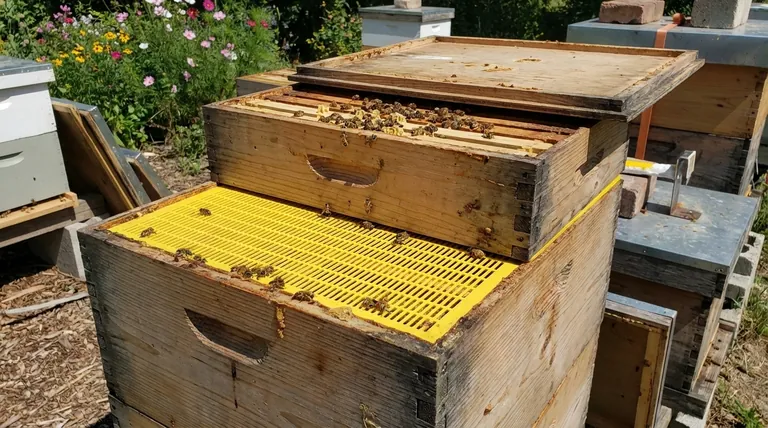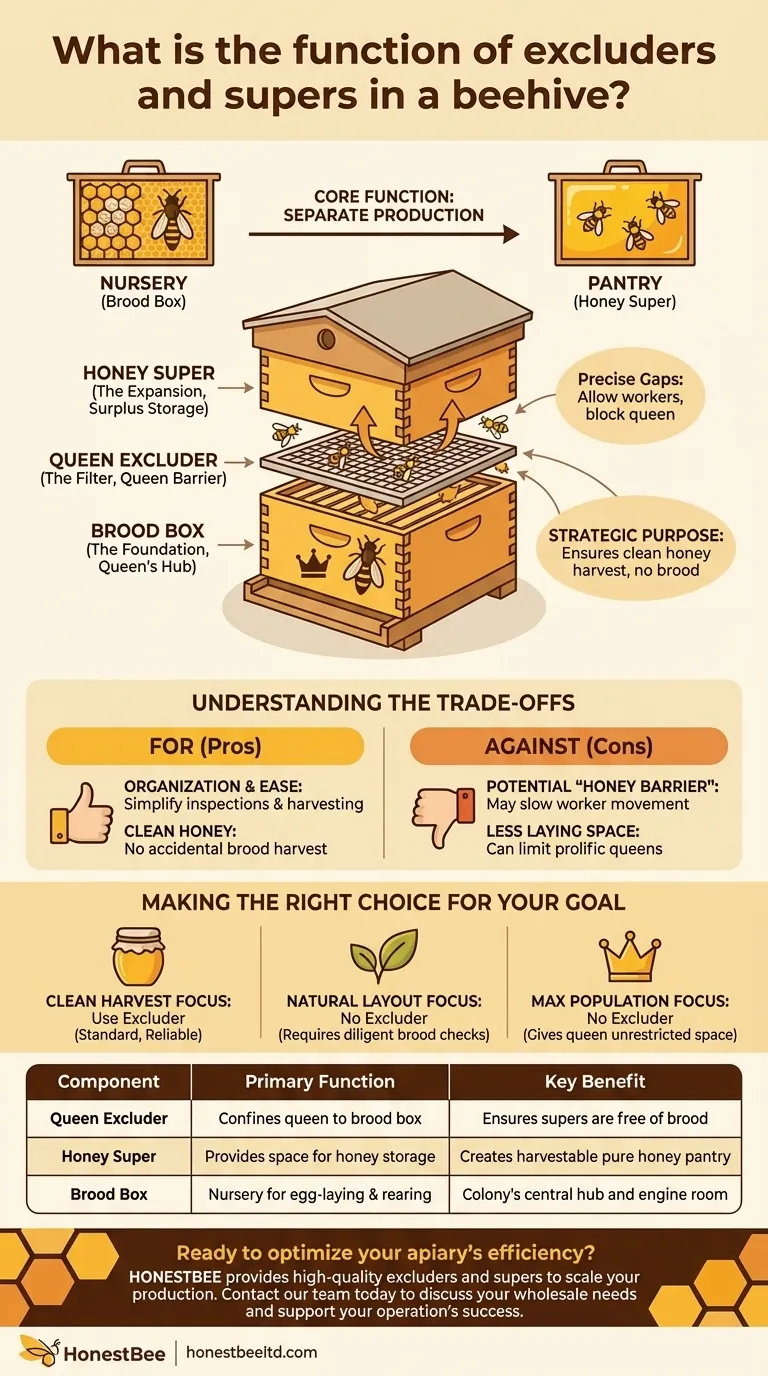In a modern beehive, the queen excluder and honey super work together as a system to separate honey production from brood-rearing. A queen excluder is a grate that prevents the larger queen bee from moving into the upper boxes, while honey supers are those upper boxes dedicated exclusively to honey storage. This separation makes harvesting clean, pure honey significantly easier for the beekeeper.
The core function of this system is hive organization. It effectively creates a "nursery" in the lower brood box for the queen to lay eggs and a "pantry" in the upper honey supers where worker bees can store surplus honey, free from developing bees.

The Anatomy of a Managed Beehive
To understand the role of these components, you must first understand the basic vertical structure of a typical Langstroth hive. The hive is built in layers, each with a specific purpose.
The Foundation: Brood Box
The lowest section of the hive is the brood box (or hive body). This is the colony's central hub.
Here, the queen lays all her eggs, and the worker bees raise the young larvae (the brood). The brood box also contains pollen and some honey to feed the developing bees. It is the engine room of the colony.
The Expansion: Honey Supers
As a colony grows and the seasonal nectar flow begins, the bees need more space to store honey.
A honey super is simply an additional box filled with frames that is placed on top of the brood box. The term "super" comes from the Latin for "above," as it is placed above the main hive body. Bees will fill these supers with surplus honey.
How the Queen Excluder Manages the Hive
The queen excluder is the critical piece of equipment that connects the brood box and the honey supers, fundamentally changing how the hive operates.
What It Is and How It Works
A queen excluder is a flat screen or grid made of wire or plastic.
The gaps in the grid are precisely sized: they are large enough for smaller worker bees to pass through easily but too small for the larger queen and drones. It is placed directly on top of the brood box, below the honey supers.
The Strategic Purpose
By placing the excluder above the brood box, you confine the queen to that lower section.
She can continue laying eggs and managing the nursery, but she cannot travel into the honey supers above. This ensures that the frames in the honey supers contain only honey, not a mix of honey, pollen, eggs, and larvae. This makes the honey harvest clean, simple, and efficient.
Understanding the Trade-offs
While the excluder and super system is highly effective for honey production, its use is a subject of debate among beekeepers.
The Argument for Using an Excluder
The primary benefit is organization and harvesting ease. You can remove an entire super of honey with confidence, knowing you won't be accidentally removing or harming the queen or her brood. This simplifies inspections and honey extraction.
The Argument Against Using an Excluder
Some beekeepers believe excluders can slightly reduce efficiency. They argue that the barrier, sometimes called a "honey barrier," can slow down worker bees as they move between the brood box and supers. This could potentially lead to a slightly lower honey yield.
Additionally, not using an excluder gives a very prolific queen more room to lay, which can create a larger workforce. However, this requires more diligent management from the beekeeper during harvest.
Making the Right Choice for Your Goal
Deciding whether to use a queen excluder depends entirely on your beekeeping philosophy and objectives.
- If your primary focus is a simple and clean honey harvest: Using a queen excluder is the standard, most reliable method.
- If your primary focus is minimizing equipment and a more "natural" hive layout: You can operate without an excluder, but be prepared to carefully check every frame for brood before harvesting.
- If your primary focus is maximizing colony population at all costs: Some experienced beekeepers forgo the excluder to give a strong queen unrestricted laying space.
Ultimately, these components are tools that allow you to manage your colony's space for a specific outcome.
Summary Table:
| Component | Primary Function | Key Benefit |
|---|---|---|
| Queen Excluder | Confines the queen to the brood box | Ensures honey supers are free of eggs and larvae |
| Honey Super | Provides space for surplus honey storage | Creates a dedicated, harvestable 'pantry' for pure honey |
| Brood Box | Serves as the nursery for egg-laying and brood-rearing | Functions as the colony's central hub and engine room |
Ready to optimize your apiary's efficiency?
As a wholesale supplier to commercial apiaries and beekeeping equipment distributors, HONESTBEE provides the durable, high-quality excluders and supers you need to scale your honey production. Our equipment is designed to streamline your hive management, ensuring a cleaner, more profitable harvest.
Contact our team today to discuss your wholesale needs and see how we can support your operation's success.
Visual Guide

Related Products
- Professional Plastic Queen Excluder for Modern Beekeeping
- No Grafting Queen Rearing Kit: System for Royal Jelly Production and Queen Rearing
- Honey Concentrating Vacuum Heating Thickening Machine Dehumidifier for Honey
- High Quality Honey Dehumidifier Dryer Thickening Machine for Beekeeping
- Lightweight Durable Plastic Queen Excluder Scraper for Beekeeping
People Also Ask
- What is the purpose of a queen excluder when adding a super? Streamline Your Honey Harvest
- What are the main advantages of using a queen excluder in beekeeping? Simplify Hive Management & Harvest
- What are the pros of using queen excluders? Boost Honey Production & Hive Efficiency
- What is the role of a queen excluder when adding a super? Ensure Brood-Free Honey Harvests
- How do queen excluders work in terms of spacing and bee movement? A Guide to Precision Hive Management



















